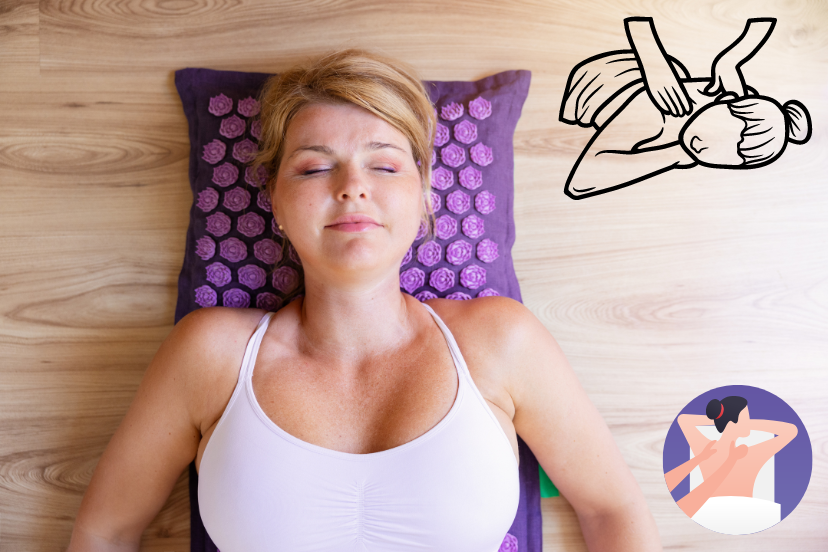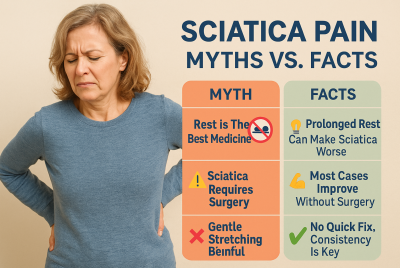Sciatica Pain Relief Massage
Discover effective sciatica pain relief massage techniques. Learn how targeted muscle massage can alleviate discomfort and enhance mobility. Let me start by saying sciatica can be a real pain in the… well, you know where. It’s a nerve pain originating from the lower back and shoots down one or both legs. The sciatic nerve, the longest and widest nerve in the human body, is usually the main character in this painful narrative, and sciatica pain relief massage can help.
Symptoms Of Sciatica
But how do you know if you’ve got sciatica? Well, some common symptoms include lower back pain, burning or tingling down the leg or hip, weakness, numbness, or difficulty moving the leg or foot, and a constant pain on one side of the rear. Keep in mind, the pain’s intensity can vary from a mild ache to a sharp, burning sensation or excruciating discomfort.
Causes Of Sciatica
Now, let’s look at what causes sciatica. Often, it’s due to a herniated disc, bone spur on the spine, or narrowing of the spine (spinal stenosis) that compresses part of the nerve. This causes inflammation, pain, and often some numbness in the affected leg. Sciatica’s origins typically trace back to specific factors. A herniated disc, spinal bone spur, or spinal stenosis, marked by spine narrowing, can exert pressure on the nerve, culminating in inflammation, pain, and occasional leg numbness. Such compression-induced effects shed light on the root causes of sciatica’s discomfort.
The Science Behind Massage For Sciatica Relief
Why am I suggesting massage as a solution? Well, let me explain. Massage therapy can provide great relief for people suffering from sciatica pain. It does this by helping the body to release pain-fighting endorphins and by stretching tight lower back muscles that are putting pressure on the sciatic nerve.
The Importance Of Massage Therapy
You see, massage therapy is about more than just relaxation. It can significantly reduce inflammation, improve circulation, and ease muscle tension. This contributes to reduced pain and increased mobility, making it an ideal non-pharmacological approach to managing sciatica.
Different Types Of Massages
Here’s a little secret – not all massages are created equal, especially when it comes to sciatica pain relief. You might find benefit from a Swedish massage, deep tissue massage, neuromuscular massage, or trigger point therapy, depending on your individual situation.
How To Perform Sciatica Pain Relief Massage
Preparing For The Massage
Before you start, remember to relax your body and mind. Comfortable surroundings and a calm state of mind can make a significant difference in how effective the massage will be. Use a comfortable and supportive surface to lie on – a yoga mat or a thick blanket should do the trick.
Techniques For Effective Massage
There are several techniques you can use. The first one is the friction technique. This involves rubbing the hands back and forth over the area to generate heat and promote blood circulation.
Next is the kneading technique, pressing deep into the muscle with your fingers or knuckles. This helps to relieve tension and improve flexibility. Then, there’s the compression technique, where you apply pressure to the muscle, helping to boost blood flow and soothe discomfort.
Post-Massage Care
After your massage, remember to drink plenty of water. This helps to flush out any toxins that have been released from your muscles during the massage. A warm bath can also help to soothe your muscles and promote further relaxation. Post-massage, hydration becomes paramount – ample water consumption aids in flushing out released muscle toxins. Augmenting this, a warm bath delivers soothing relief to muscles and fosters extended relaxation. By adhering to these practices, you optimize the benefits derived from your massage session.
Other Non-Medicinal Remedies For Sciatica
Massage isn’t the only method to manage sciatica pain. Here are a few more non-medicinal remedies that can provide relief.
Stretching And Exercise
Regular physical activity and specific stretching exercises can help to strengthen the muscles that support your back, improve your flexibility, and prevent future sciatica pain. Regular physical activity and targeted stretching routines hold immense potential in fortifying the muscle groups crucial for back support. This practice not only enhances flexibility but also serves as a proactive shield against prospective bouts of sciatica discomfort. By maintaining a consistent exercise regimen, individuals can foster a resilient back and diminish the likelihood of sciatic pain recurrence.
Hot And Cold Therapy
Heat can help to loosen up your muscles before you stretch and exercise, while cold therapy can help to reduce inflammation and numb your pain after you’re done. Remember, don’t apply heat or cold directly to your skin – always wrap it in a towel first. Incorporating hot and cold therapies into your routine can yield remarkable benefits. Before exercising, heat aids in muscle relaxation and preparation. Post-workout, cold therapy combats inflammation and alleviates pain. To ensure safety, remember to shield your skin by wrapping the heat or cold source in a towel before application.
Acupressure For Sciatic Pain
Acupressure can offer relief for sciatic pain through targeted pressure on specific points. However, expertise is crucial, as wrong pressure can be harmful. Consult an acupressure practitioner or healthcare expert to ensure safe and effective pain management tailored to your condition.
What Pressure Point Relieves Sciatic Pain?
There isn’t a single pressure point that universally relieves sciatic pain, but specific acupressure points may provide relief. The “B48” point, located in the center of the gluteal muscles, can be gently pressed for tension release. The “GB30” point near the buttocks’ edge might help alleviate pain. Another effective spot is the “BL23” point around the waistline, which could aid lower back discomfort. However, using pressure points requires knowledge and precision, as incorrect manipulation can worsen the condition. Consulting a professional acupuncturist or healthcare provider is advisable to identify suitable pressure points and techniques tailored to your pain’s underlying cause and individual needs.
Mindfulness And Relaxation Techniques
Practicing mindfulness can help you to manage your pain by changing your perception of it. Techniques like deep breathing and meditation can also help to relieve stress, which can further exacerbate your sciatica symptoms.
Relaxation techniques can indeed help with sciatica pain. The stress and tension associated with chronic pain conditions like sciatica can exacerbate the pain experience. Techniques such as deep breathing, progressive muscle relaxation, mindfulness, and meditation can help reduce stress levels, promote relaxation, and potentially help manage pain.
These techniques work by helping individuals shift their focus away from pain, reduce muscle tension, and decrease stress, all of which may contribute to the pain experience. However, it’s important to note that while these methods can help manage sciatica symptoms, they should be used as part of a broader treatment plan, not as a standalone solution.
Sciatica Pain Relief Massage At Home

Massage can help reduce muscle tension, improve circulation, and stimulate endorphin release, which can provide temporary relief from sciatica pain.
Start by identifying the piriformis muscle located in the buttock, which can often contribute to sciatica pain when it compresses the sciatic nerve. Using a foam roller or even a tennis ball, apply gentle pressure on the muscle. Do not apply direct pressure on the lower spine or the sciatic nerve itself, as it may worsen the pain.
You can also massage the lower back and hamstring muscles to provide overall relief. Always be gentle and stop if the massage causes more pain. It’s recommended to consult a professional therapist or healthcare provider before starting any new treatment at home.
Is It OK To Massage Sciatica Pain?
Massaging sciatica pain can be beneficial if done correctly and with caution. Gentle, targeted massage of the surrounding muscles can help alleviate tension and promote blood flow, potentially relieving pain. However, direct pressure on the sciatic nerve or overly vigorous massage can worsen the condition. It’s advisable to consult a healthcare professional before attempting self-massage, especially if you’re unsure about the underlying cause of your pain. A trained therapist experienced in sciatica can provide appropriate techniques to help without exacerbating the issue.
Where Do You Massage For Sciatica Pain?
When massaging for sciatica pain relief, focusing on the muscles surrounding the sciatic nerve pathway is essential. The leg’s lower back, buttocks, hips, and back are crucial. Begin with gentle, broad strokes to warm up the tissues. Then, apply deeper pressure using your fingertips, knuckles, or palms, focusing on the tense or painful spots. Avoid direct pressure on the sciatic nerve itself. Instead, target the gluteal, piriformis, and lower back muscles. Gradually work your way down the back of the leg while adjusting pressure based on comfort. If uncertain, consult a professional massage therapist or healthcare provider for proper guidance to ensure safe and effective relief.
What’s The Best Way To Massage Your Sciatic Nerve?
Massaging the sciatic nerve requires a cautious approach. Instead of directly massaging the nerve, please focus on the muscles around it to alleviate tension. Begin gently to warm the area, then apply deeper pressure using your knuckles, fingers, or palms. Concentrate on the gluteal, piriformis, and lower back muscles, often contributing to sciatic pain. Utilize kneading and circular motions to release muscle tension. However, avoid excessive pressure or painful areas. Consult a qualified massage therapist or healthcare professional for guidance. If you experience worsening pain, numbness, or discomfort during massage, cease immediately. Safety is paramount; a professional can tailor techniques to your specific needs for effective relief.
Sciatica Massage Gun
A sciatica massage gun is a handheld device that alleviates sciatic pain through percussive therapy. It utilizes rapid and targeted vibrations to stimulate blood flow, relax muscles, and reduce discomfort. When used correctly, the massage gun can offer relief by targeting the muscles around the sciatic nerve pathway. However, caution is crucial, as applying excessive pressure or using it directly on the nerve can worsen symptoms. Individuals with sciatica should consult a healthcare professional before using a massage gun ensuring it’s appropriate for their condition. A therapist or medical expert can guide them on proper technique, frequency, and areas to target for safe and effective relief.
Is Vibration Massage Good For Sciatica?
Vibration massage can benefit sciatica by promoting muscle relaxation, enhancing blood flow, and reducing pain perception. However, its effectiveness varies among individuals and depends on the underlying cause of sciatica. Vibrational massage tools, like handheld devices or massage chairs with this feature, can target specific areas gently. The vibrations help alleviate muscle tension around the sciatic nerve pathway. But caution is necessary – excessive pressure or vibration directly on the nerve can worsen symptoms. Consulting a healthcare professional before using vibration massage, especially if you’re unsure about your condition, is wise to ensure it’s suitable and safe for your situation.
Frequently Asked Questions (FAQs)
Can I do a sciatica pain relief massage at home?
Absolutely! However, it’s recommended that you learn the correct techniques from a certified therapist first to avoid causing further harm.
Can exercise make my sciatica worse?
It’s possible if you’re doing the wrong exercises or doing them incorrectly. Always consult with a physiotherapist or a certified trainer to ensure you’re doing the right exercises for your condition.
How often should I get a massage for sciatica?
There isn’t a one-size-fits-all answer to this. The frequency of your massages will depend on the severity of your pain and your personal needs.
Is a foot massage good for sciatica?
While a foot massage can provide general relaxation, it might not address sciatica’s root cause directly. Targeted massage of muscles around the lower back, hips, and buttocks may offer more effective relief for sciatic pain.
Does massage help nerve pain in the legs?
Massage can relieve nerve pain in the legs by promoting circulation, relaxing muscles, and reducing overall discomfort. However, consult a healthcare professional for proper guidance and to determine the underlying cause of the pain.
Extra FAQs Related To Sciatica Pain Relief Massage
Where to massage for sciatica?
For sciatica relief, focus on massaging the muscles around the leg’s lower back, buttocks, hips, and back. Avoid direct pressure on the sciatic nerve itself. Consulting a healthcare professional or massage therapist is advisable for safe and effective techniques.
How long does sciatica pain usually last?
Sciatica pain can last for a few days to a few weeks. However, seeking medical attention is essential if it persists beyond a few weeks.
Can sciatica be cured permanently?
While sciatica can often be effectively managed, a permanent cure isn’t guaranteed as it largely depends on the underlying cause. Consistent lifestyle modifications, regular exercise, proper posture, and treatments such as physical therapy, medication, or surgery, can significantly alleviate symptoms and prevent recurrence. However, some individuals may experience recurrent or chronic sciatic pain. Always consult a healthcare professional.
Sciatica can be treated effectively, but it depends on the underlying cause. In some cases, lifestyle changes and physical therapy can help manage symptoms and prevent future occurrences.
Sciatica Pain Relief Massage – Conclusion
So, there you have it – a comprehensive guide to sciatica pain relief massage. Remember, everyone’s experience with sciatica is unique, and what works for one person may not work for another. It’s always important to consult with a healthcare professional or a pain management specialist before starting any new treatment, to better understand how to incorporate relaxation techniques into your treatment plan.
Disclaimer
Please note that this article should not replace professional medical advice. Consult a healthcare professional for an accurate diagnosis and tailored treatment plan.
👉 Explore more:





